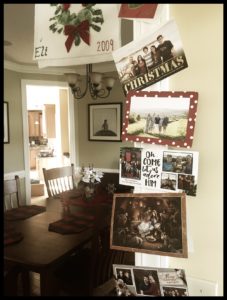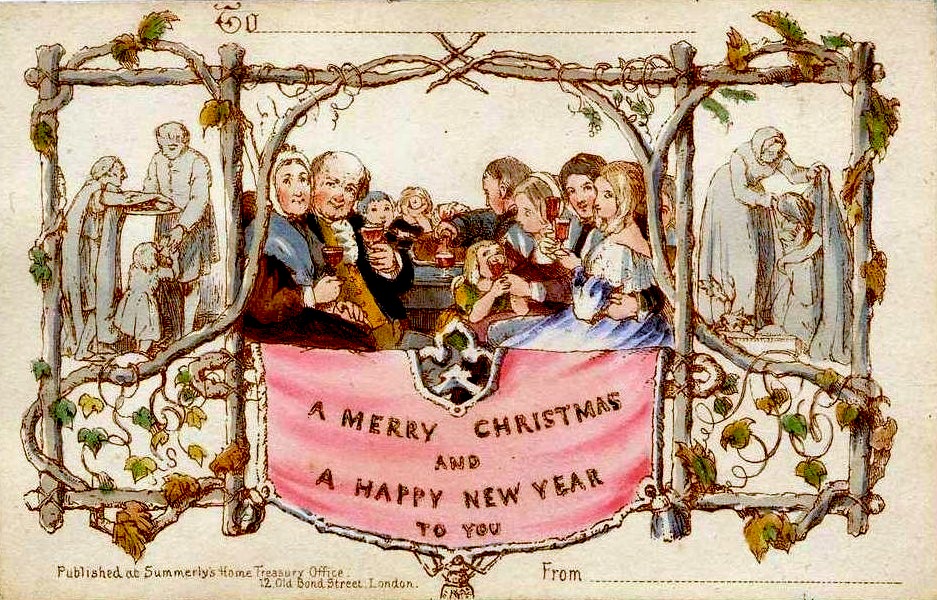Every year, as I seek to shorten my list of Christmas to dos, and therefore limit my holiday exhaustion, I ponder The Christmas Card. Is it worth coercing my people to pose for a picture? And if yes, what should we wear? Should I write a letter, or is a brief blurb on the back of the card enough?
The Christmas Card takes a lot of energy: assembling the family unit; enduring the grumbling; running between the tripod and the family huddle before the shutter timer goes off; designing the perfect photo card; choosing the perfect words. And then there’s the mail merge (I don’t print mailing labels enough; each year I must relearn the process) and the hours spent signing, stamping, sealing.
Christmas would be simpler without The Card.

But I love GETTING cards. I can’t wait to see how families and friends have grown and changed over the year. I lament that in many cases, communication has been reduced to this annual ritual, and yet I’m thankful to at least have that. I devour the letters that come with cards; I wish more did.
And so, every year, I make the photo card and compose the letter. I never use verse or acrostics (some people are very creative!), but write a family update, allowing one paragraph for each Tomiak. I try to keep it real with snippets and quotes from our daily lives. I avoid boasts and saccharine sweet sentiments. I hope to create something informative and entertaining.
This year, as if they heard my doubts, a few friends and family have made the time to tell me how much they love and look forward to my letter. I appreciate the fact that in this busy world, at this busy time, if people make the effort to complement you, they usually mean it.
So The Christmas Card is a tradition I will keep. Which of course leads to the Word Nerd question, how did the tradition of sending cards start?
Way back in 1843, in Victorian England, a man named Henry Cole had a problem: too many friends. The custom of sending a Christmas letter had been around for a long time in England, but it got even more popular with the introduction of the “penny post”. People could send a card or letter anywhere in the country for just one cent. Mr. Cole didn’t want to neglect his duties of correspondence, but he simply didn’t have enough time to write everyone in his social circles. So he had an idea.
Mr. Cole asked his friend J.C. Horsley, an artist, to create a Christmas illustration. Cole printed that image on 5×3 inch pieces of cardboard with the generic greeting, “A Merry Christmas and a Happy New Year to You.” Cole could still personalize the postcard by writing a name at the top, but the bulk of the work was done, and the first Christmas Card was made.

It took awhile for the tradition to catch on in the United States. Louis Prang, a Prussian immigrant with a print shop near Boston, created the first Christmas card in the United States in 1875. The custom didn’t truly get popular until 1915 when the founders of what would eventually become the Hallmark company introduced a new format for the card: bigger, folded like a book, mailed in an envelope. The business boomed in the 1930s and 1950s and continues to be popular today.
It seems to me, we are going back to the original idea of a decorative post card. Most of the cards I get are a single page, usually with a picture and a sentiment. I love them, and I keep many displayed throughout the year as a reminder of friends and family who live far away.
If you’d like to learn more about the history of The Christmas Card, visit Smithsonian.com.
Do you send holiday cards? What format do you prefer? What do you do with the holiday cards you receive?
Happy Holidays!



I send out a photo card every year, although I skipped 2016 and 2017. I did receive less this year, but I had a few notes from my husband’s aunts letting me know how much they enjoy receiving the cards each year. I don’t do a letter, but I also love getting cards from friends near and far. A belated Merry Christmas to you, Julia!
I, too, love getting cards each year. I hope our friends do as well, since we sent out 183 this year. Each card is the same and I buy them on sale in the summer from The Met Museum Store. A two page letter is enclosed with information about our travels and news about our children, grandchildren and yes, now great-grandchildren. There are lots of pictures printed in the letter. We have changed locations frequently and made friends at each new duty station and each new neighborhood, so this is how we stay in touch. I devour the ones we receive. If they are too busy to read ours, that is okay. At least we did our part. I love reading your posts!